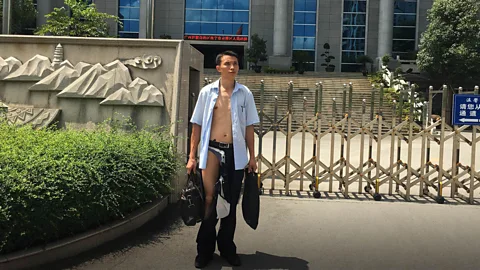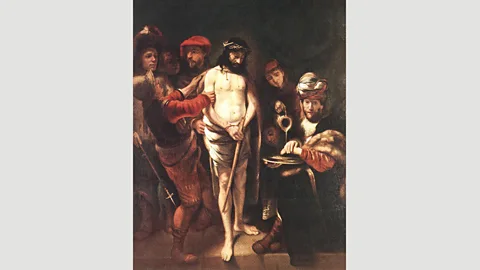The man who had his clothes torn off
 Wu Liangshu
Wu LiangshuPhotos of a Chinese lawyer who was allegedly attacked by policemen in court went viral this week. Kelly Grovier explores the history of violent disrobement.
It is an archetypal scene, rehearsed countless times on the cracked surfaces of ancient altar panels and on the stretched-linen canvases of art history: a sacrificial figure, humiliatingly stripped of his clothes by brutish authorities, stands before a court of justice. But in this instance, the image does not date back to medieval or Renaissance Christian iconography and it is not to be found on the walls of a Western museum, church, or cathedral.
Rather, the digitised pixels that comprise the photo of a bedraggled Chinese lawyer, who was allegedly assaulted by policemen this week before a panel of judges in a district court in China, have pulsed through the optic fibres of online news platforms and social media, leaving readers across the globe aghast at the sight of such apparent judicial thuggery.
 Wu Liangshu
Wu LiangshuThe photo was captured in Nanning, Guangxi, shortly after the lawyer, Wu Liangshu, was informed that his request to file a case had been denied. Accused of illegally recording court proceedings, Wu was ordered to hand over his mobile phone for inspection. When he refused, he claims that court officials violently attacked him and nearly ripped his clothes entirely off his body. Aware that his tattered appearance would resonate more powerfully as a statement against state brutality than anything he could say or write, Wu strode from the courthouse and stood in the crosshairs of the camera lenses waiting outside.
The result is an astonishing image that, through the aperture of Western aesthetics, seems to echo the choreography of many depictions of the soon-to-be-crucified Christ, arrested, man-handled, and frog-marched to judgment before the high priest. While the secular photo of Wu is necessarily stripped, as it were, of any religious connotations, his violent disrobement within a farcical arena of cynical state justice is nevertheless a culturally shared posture – one that locates Wu in the tradition of memorable portrayals of Christ from the Middle Ages to the 20th Century.
 Wikimedia
WikimediaIn particular, the photo is intensified when placed next to a 17th-Century painting, Christ before Pilate (1649-50), that was long thought to be by Rembrandt. Now attributed to the Dutch painter Nicolaes Maes, the work features the limp but undefeated physique of a beleaguered Christ whose clothes have been confiscated. The contrast between Christ’s skin and the finery of those who stand in blank, empty-eyed judgement of him finds its parallel, in this week’s photo, in the disparity between Wu’s shabby appearance and the idealised landscape chiselled into the stone frieze behind him, doubtless intended to symbolise the sturdiness of justice.
100 Works of Art That Will Define Our Age by Kelly Grovier is published by Thames & Hudson.
If you would like to comment on this story or anything else you have seen on BBC Culture, head over to our Facebook page or message us on Twitter.
And if you liked this story, sign up for the weekly bbc.com features newsletter, called “If You Only Read 6 Things This Week”. A handpicked selection of stories from BBC Future, Earth, Culture, Capital, Travel and Autos, delivered to your inbox every Friday.
